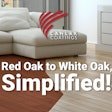Avi, thanks for the chance to comment on your post about bamboo and engineered flooring, and sorry for the late reply.
Well, as you can imagine, I don't fully agree with your position. I think that the issue for much of what you listed in your blog post is not a factor of a specific product category itself, but the production quality of an individual item. I think these most of the items you listed can be just as green, and by some standards, even more green than solid is.
You've certainly seen a lot of solid flooring that was badly dried (either too wet or too dry), that was badly machined, that failed on the job site or required excessive sanding to make flat or whatever. You've cut your share of material in half to get out a twist. You've seen the failure of good flooring that was installed on wet subfloors. You've heard the squeaks and felt the bounce caused by insufficient nailing. You've winced to see dust damage on a finish. I'm sure there's been cases where poor sanding left marks that just made you cry when the sunlight hit them…
For all categories of products, be it solid or engineered, bamboo or oak, prefinished or site-finished, I think the first question is the quality of production and then the quality of the install. After that, it's up to debate as to which item is more "green" than another depending on your definition or focus of being green.
A strand floor product or an HDF core both will use a lot of glue and processing power to make, but it can use a lot of scrap material that otherwise would be wasted-one negative, one positive. Plus strand goes beyond just bamboo these days to utilize a lot of different species that otherwise would just be wasted. For all of these and other engineered flooring, both general recovery and maximizing quality recovery is a big factor. A high-quality tree can be used to make many more square feet of floor than it could do in solid applications. And a 4- or 5-mm wear layer on engineered has pretty much the same refinishing life as a solid floor, while we'd all look at a 0.6-mm face as wearing out about the same as laminate. But yes, engineered flooring can also take a bit more processing power and glue to make.
What else? Job site finishing might be easier to sand down in a few years, but cost to consider. The bottom line is that these are complicated issues.
Is ash "greener" then oak because it dries faster? Is a rustic "greener" than a clear-color matched floor? Is a 2-inch recovery width better for the environment than a 6"-inch, or should we go wide to use less nails and glue? Should we never use a vertical-grain product because it requires a lot more waste to saw? Walnut is still, I believe, the one U.S. hardwood with a negative growth rate (we cut more volume than is being grown)-do we stop using it? Or is it more green than others because we get to use the nuts for years before we harvest for timber? Nothing's simple…
Some people buy just because it's American and not want to even look at a tropical product, even if it's FSC-certified-the "Made in USA" is their defining purchase point. Some folks get solid just because its SOLID and they don't even think that maybe in the 8-inch width they want, engineered might be a bit more stable and perhaps a better use of a resource… (I once saw an architect in Japan use 6/4 x 10" FAS red oak for his flooring. It didn't strike me as the greenest floor out there, but it was definitely SOLID.)
I agree completely that pulling up a floor shortly after install is a complete waste. So again I think to start with green, you start with a quality product. After that, the question becomes where your priority is-resins or carbon sinks or transportation or recyclability or whatever it is... There are so many different approaches to consider. I think you know my position, that there are shades of grey in being green, that nothing is black and white.
I'd like to see you look at pros and cons of each item from your unique contractor's point of view. If you have tips to help avoid failure, that would be a green thing to offer up-people are going to keep using composites and engineered and bamboo for some time to come, so what can we do to educate them to pick the right product and to use it the right way? Is there a better nail type or nailing pattern to use? Got a recommended glue for one product over another? Suggestions on subfloors? What do you look for in an engineered floor construction?
Solid is a great product with a lot to cheer about. The U.S. hardwood resource is a terrific one-it's well-managed and growing. If you are buying from a mill next door, that's also great news, not just for reduced transport issues, but because you're helping your neighbor. I don't think we have to say the other products are bad to say that one is good. There are plusses and minuses in all of these, and I, for one, am delighted we have so many choices within our industry so we can pick the look and the product and the specific "green nature" that is matches our own sensibilities.
































